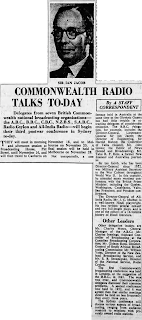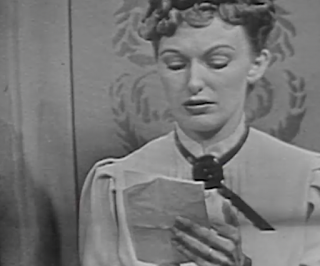The first drama on the ABC. Aired on the first night the ABC broadcast.
The play was filmed again a few months later in Melbourne.
Premise
Sir Harry Sims is a wealthy businessman who is about to be knighted. He hires a typist to help him with responding to letters of congratulations. It turns out the typist, Kate, is Sir Harry's first wife; she left him years ago in order to be independent.
Cast (in order of appearance)
* Joan Lord as Lady Sims
*Alexander Archdale as Sir Harry Sims
* John Brunskill as Tombes
*Margo Lee as Kate (left off the credits!)
*Joan Lord as Lady Sims
Original play
It's by J.M. Barrie who is best known for
Peter Pan and for being played by Johnny Depp in the film
Finding Neverland. Has JM Barrie been cancelled? I think it's accepted he was creepy when it comes to young kids.
In a 1915 interview he said he wrote the play recovering from malaria - see
here.
It's
quite a good little play.
Surprisingly feminist too. Barrie did a bit of work along the Battle of
the Sexes line. A bombastic man is about to be knighted; a
woman comes to type letters... it turns out she's his first wife who
took off because she couldn't stand him and wanted independence (to
learn to type). And she isn't punished. I enjoyed reading this a lot.
I do think the first Australian drama should have been an Australian story, but this was fun.
The play was a bit of a touchstone for talking about female "new independence". For instance it was mentioned in a 1938 SMH article about women
here.
Other adaptations
It was performed on stage in Melbourne in
1920,
1925. Sydney in
1921.
In Feb 1956 the ABC broadcast a
BBC radio version (a transcription). See
here. Betty Ann Davies starred.
Here's a clip from an ep of
Omnibus see
here and
here.
Production information
The first ever play performed on Australian TV by Australians.
Presumably chosen because it was easy: short, three actors only, each
role had a bit of meat. The play seems to have been quite popular among theatre companies at the time.
In the early days of our TV operation, our requirements will be comparatively modest. Having no proper drama production studio until the end of April, our activities will be limited to those simple productions which can adequately be handled in a small presentation studio, 20 feet by 30 feet. Elaborate hour plays, calling for several sets and much floor space, will clearly have to await the completion -of larger premises. Our first productions will be half hour plays consisting of no more than two sets and calling for no film sequences— which are commonlv used when the play’s action demands a number of out door scenes. Film inserts are shot on location well before the time of studio production and are interpolated in the live action for the first time when the show is rehearsed in the studio on the day of transmission. One of the big problems with which we are faced is the securing of TV drama scripts. Australian writers have not yet begun to think in terms of television and it may well be some time before they get the hang of what is required.
The play aired in Sydney on 5 November 1956, the first night the ABC broadcast in Australia. (The commercial networks beat them to the punch.) So there was Australian TV drama the first night the ABC aired. It's just it wasn't an Australian story.
The famous ABC studios at Gore Hill in Sydney hadn't opened yet so this was filmed at the Arcon Studios in Sydney.
It was directed ("produced") by
Paul O'Loughlin, a very experienced actor and director on radio. He would go on to do a little TV drama but wasn't one of the "big four" of the early days (that would be Chris Muir, Will Sterling, Alan Burke and Ray Menmuir). Paul O'Loughlin was born in Melbourne. He studied law and joined the
ABC in 1935. He worked for the ABC in Adelaide (from 1937) and Brisbane and joined the
Sydney section in 1940. He joined the army and transferred to the RAAF, serving in 33 missions over European - his wife did this article on him
here. By
1948 he was the senior producer at ABC Sydney.
In January 1950 he went on exchange
to the BBC; in return the ABC got Ayton Whitaker. O'Loughlin spent three weeks at Alexandra Palace learning about television but mostly worked in light programs. He returned
by October 1950 saying how much he liked French acting but he thought Australian radio actors were among the best in the world. He did urge them to get
more stage experience to help with Tv.
By Dec 1950 he was appointed
assistant director of Drama and Features. (While he was in Australia, Ayton Whitaker criticised Australian acting - see
here. Whitaker was anti TV see
here). O'Loughlin in
Dec 1956 directed a radio adaptation of
The Fortune of Richard Mahoney. He continued to alternative TV and radio. His producing credits seem to stop after 1959. He became
acting head of drama.
The actors were very experienced stage and radio actors. Alexander Archdale particularly. He had done TV plays at the BBC. Margot Lee had been in I Found Joe Barton.
Thelma Afford did the design, as she did for many early Australian TV plays. You can read about her efforts in an article for the
Woman's Weekly here (
http://nla.gov.au/nla.news-article48530309) or at the
Sydney Morning Herald article I've printed.
There's also a mention of her work in an ABC Weekly article
here. She said in an oral history
here that "It was interesting to find that the early TV cameras were sensitive to white as were the earlier film ones."
Mike Charlton crossed to the drama studio around 7.30 pm, after a variety act, "where the ABC drama department it waiting to make its bow to TV viewers". They cross over and floor manager Brian Rhys-Jones takes off his headphones and talked about what he did then introduced Paul O'Loughlin. A nervous looking O'Loughlin discusses the crew. He calls it "one of Barrie's most charming comedies" and then "pretend I'm a theatre program at the moment" and introduces the cast, giving brief bios of the lead four. Archdale was British and Joan Lord had acted in Britain ("made quite a name for herself in theatre and in television which she is no novice at all"). Then Rhys-Jones cuts him off.
Mungo McCallum talks about that first night (though only mentions the play briefly)
here and
here.
The same play was filmed in Melbourne the following year.
There were no stuff ups. There were on other things that happened that night -
read this article.
The NAA has photos (not online) - see
here.
 |
Cast photo of original 1956 Sydney production
|
Crew
Costume designer - Set designer - Dennis Grafton. Technical producer - Dave Tapp.
Reception
The Australian Woman's Weekly called it "hard to fault".
Leslie Rees, in his memoirs, called it "a brilliant production" full of "photographic mesmerism". He says the camera would follow Margot Lee around. Rees says this "got ABC TV drama off to a good start".
 |
Leslie Ree, Hold Fast to Dream, p 206
|
 |
Leslie Rees,Hold Fast to Dream p 207
|
 |
Auntie's Jubilee
|
 |
Aunties Jubilee
|
 |
| Paul O'Loughin | | | | | |
|
|
Opening Night Line Up
- Mike Charlton
- Dignitaries speak: Sir Richard Boyer, Robert Menzies, Charles Davidson,
- Outside broadcast.
- Vision of violinist with no sound.
- Charlton introduces Douglas Channel.
- Cut to the drama studio. Brian Rhys-Jones and Paul O'Loughlin discuss the night's show.
- Cut back. Charles Moses and Sir Ian Jacob.
- Frank Legg and a cat. Talk to owner of a antique store, a man and his daughter who sail around the world, Julitha who sings Aboriginal songs, Rossi's two children and a puppet.
- Mike Charlton and James Dibble
- The Twelve Pound Look



































No comments:
Post a Comment